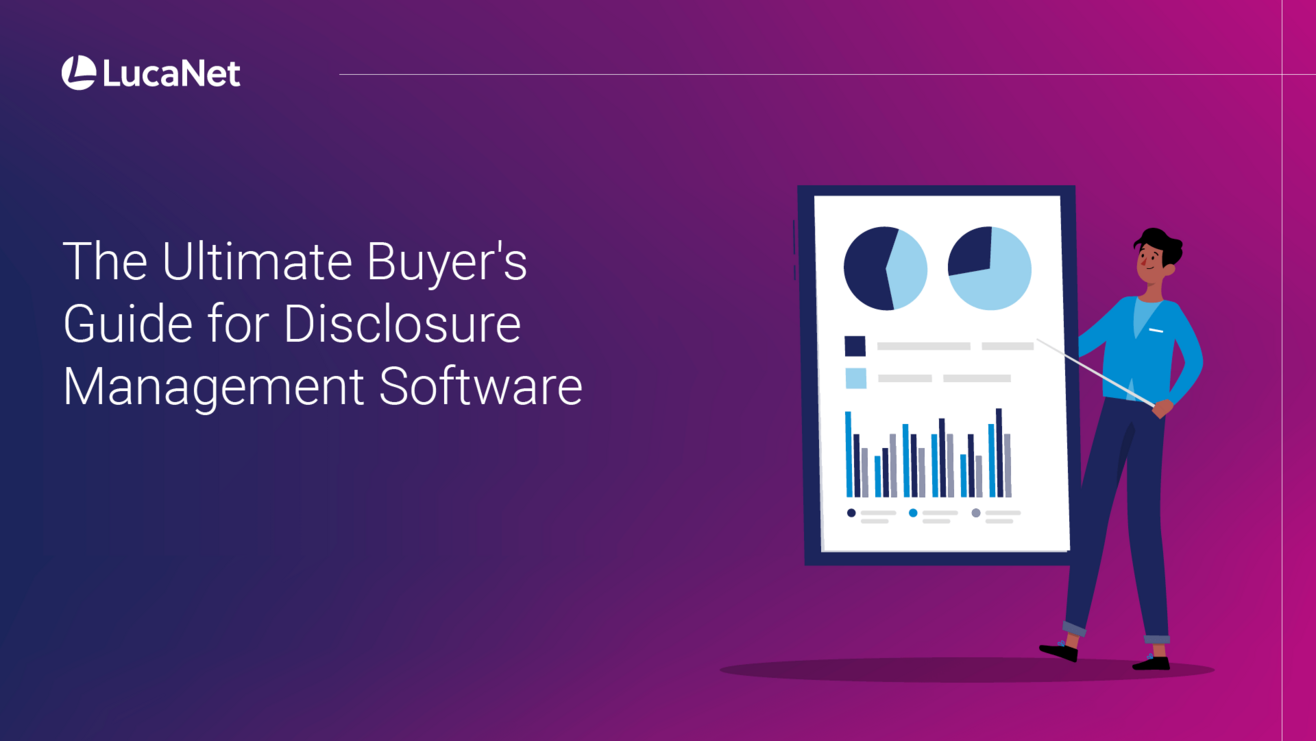Level Up Your Disclosure Management with Cutting-Edge Software for Annual Reports

Disclosure management – What is the purpose?
Disclosure management as part of your financial, management or statutory reporting is a crucial process for any organization. It ensures that the organization complies with legal regulations and maintains transparency with stakeholders.
Preparing, reviewing and reporting financial and non-financial data
This practice involves preparing, reviewing, and submitting important financial and non-financial information to regulatory bodies, shareholders, and the general public.
Financial statements, annual reports, and other corporate disclosures provide a comprehensive overview of an organization's financial health, performance, and future prospects. Accurate and timely information is essential for stakeholders to make informed decisions, such as investors analyzing investment opportunities or creditors evaluating a company's creditworthiness.
Prioritizing disclosure management allows businesses to gain a competitive advantage and strengthen their relationships with stakeholders in an increasingly complex regulatory environment.
Unlock the objectives of disclosure management
Disclosure management facilitates informed decision-making by stakeholders, such as investors, creditors, regulators, and the public. By ensuring that all necessary information is disclosed in a clear and accessible manner, organizations can build trust, enhance credibility, and foster strong relationships with their stakeholders.
The core objectives are:
Facing the challenges of disclosure management
As a contributor to the reporting who is tasked with creating parts of a report, such as the management, statutory or the sustainability report, you understand the importance of effective disclosure management. It is vital for ensuring accurate and transparent reporting.
However, the different teams in this process face numerous challenges in this process that can hinder their ability to meet regulatory requirements and deliver timely disclosures.
The challenges of disclosure management include:
Organizations often deal with vast amounts of financial and non-financial data from multiple sources, in various formats, and governed by different regulatory standards. Managing and consolidating this complex data manually can be time-consuming and prone to errors.
Always be compliant with ever-changing regulatory requirements and reporting standards such as GAAP, IFRS and ESRS is a challenge. Failure to meet regulatory obligations can result in penalties, reputational damage, and legal consequences. A flexible format for disclosure that always complies with legal requirements and ensures quick calculation is needed.
Meeting tight reporting deadlines is essential for organizations. The timely preparation and submission of financial reports requires efficient processes and coordination among teams, which can be difficult to achieve manually.
Collaboration among different departments, such as finance, legal, and compliance, is crucial for accurate and consistent disclosures. Coordinating feedback, managing multiple versions of documents, and maintaining a clear audit trail can be challenging without a proper tool.
Ensuring data accuracy and integrity is vital for reliable disclosures. Manual processes increase the risk of errors, inconsistencies, and data manipulation, all of which can undermine the trust and credibility of the disclosed information.
It is a challenge to assemble the report sections that have been created separately into a final, consistent output that must be in a specific format. In the past, the output may have been only a printable format such as a Word document or PDF file, but several legal and regulatory filings require electronic submission, including XBRL tagging. Often companies use external sources to produce these reports, and these service companies often use publishing tools such as InDesign, etc.
As organizations grow and operate in multiple jurisdictions, the volume and complexity of disclosure requirements increase. Managing the growing number of disclosures efficiently becomes a challenge without scalable tools and processes.
How to report on ESG topics?
Is your disclosure management process ready for ESG topics?
In addition to the usual disclosure of financial data, including aspects of corporate development, financial strategy and risk management, some companies are already obliged to disclose non-financial information.
Based on the new regulatory requirements as part of the CSRD, a large number of companies will have to report their key figures in the areas of Environment, Social, and Governance in the coming years. It is therefore crucial that you start thinking about integrating your sustainability report into your disclosure management process.
How to manage an ESEF iXBRL reporting?
Do you know how to manage an ESEF iXBRL reporting in disclosure management?
ESEF iXBRL reporting refers to the electronic reporting format mandated by the European Securities and Markets Authority (ESMA) for companies listed on European stock exchanges. ESEF stands for European Single Electronic Format, while iXBRL stands for Inline eXtensible Business Reporting Language.
What is the difference between XBRL, iXBRL, and iXBRL tagging?
XBRL (eXtensible Business Reporting Language) is a data format originally based on XML used for digital reporting. It basically allows unique tags to be associated with reported facts and is thus often called “bar codes for reporting”.
Inline XBRL (iXBRL) is one of many XBRL specifications that allows filers to create one single document that is both readable by machines and humans, eliminating the need for two separate reports. iXBRL reports are XHTML documents with embedded XBRL information.
The LucaNet XBRL Tagger is an XBRL certified software and allows users to load existing PDF and Word reports. After an automatic conversion to XHTML users can assign specific tags, provided by the regulators in the form of XBRL taxonomies, to financial and non-financial information. The tool hides the complexity of XBRL and enables the preparers to focus on their area of expertise. The XBRL Tagger is a bolt-on solution and the market-leading software for ESEF reports.
Challenges of ESEF iXBRL reporting
ESEF iXBRL reporting presents certain challenges, including the need for proper tagging of financial data based on the ESEF taxonomy and compliance with the ESMA ESEF reporting manual. ESEF also requires all filers to create their own entity-specific taxonomy extension, basically making each company an XBRL taxonomy author.
However, with the right tools and software, companies can streamline the process and ensure accurate and efficient reporting, ultimately enhancing transparency and facilitating cross-company analysis for investors and regulators.
The special case in the UK: What to consider with UKSEF
The role of the UKSEF taxonomy in uniform and analyzable reporting
The role of the UKSEF taxonomy is to provide the structure necessary for accurately tagging financial information. It is based on the IFRS (International Financial Reporting Standards) taxonomy, which is a standardized classification system used for financial reporting. By following this taxonomy, companies can create reports that are uniform and easily comparable and analyzable.
If there is information that needs to be tagged but is not available in the IFRS taxonomy, companies need to create an extension. This means that the UKSEF report package will not only contain the main xHTML-based file but also an additional taxonomy specific to the company, which includes information relevant only to that issuer.
For UK filers, the UKSEF consists of the ESEF taxonomy mentioned earlier, as well as an additional taxonomy with UK-specific information. Filers must choose between using either the FRS102 or IFRS entry-points for the second taxonomy in their reports.
Overall, the UKSEF is an important tool for UK-based companies to comply with filing requirements and ensure the accurate and standardized reporting of their financial information. With the transition to digital submissions and the adoption of the UKSEF taxonomy, the process of filing annual reports in the UK is becoming more streamlined and efficient.
How to choose a professional software tool for disclosure management?
Automation technology has transformed disclosure management. Software solutions streamline the process, reducing manual tasks and enhancing accuracy. These tools centralize data and facilitate collaboration among different teams and departments. Automation ensures consistency in reporting, simplifies updates and revisions, and minimizes errors.
In the following chart you see a comprehensive overview of the capabilities you should look for in a disclosure management software. Use it to identify software that enables compliant annual reporting and prepares you for ESEF and ESG.
Your disclosure management software checklist:
- Quick extension for ESEF and ESG requirements.
- End-to-end application that covers the complete process from data capture, submission, and reporting.
- Easily importing data with user-friendly interface.
- Full control over changes with a comprehensive audit trail.
- Uniform user interface that enhances recognition and usability.
- Print-ready layout without any media discontinuity.
- Automated data flow into Disclosure Management and integrated (i)XBRL tagging for combined financial and ESG reporting.
- Data consistency throughout the entire document and across all reporting languages with a defined single point of truth.
We were able to save about 1-2 days in the finalization process, as a lot of manual work was reduced due to the automated updating of tables and continuous text figures as well as fixed formatting. This led to significant reduction of the various rounds of clarification in the end.
Boost your disclosure management with efficiency and transparency
Struggling to find the right solution for your ESG or ESEF annual report? Look no further.
Automate your reporting process with the end-to-end solution SmartNotes to efficiently produce consistent, optimized and auditable reports, saving costs and streamlining complexities.
With SmartNotes, you can quickly and seamlessly integrate ESEF and ESG, cover the entire process from data capture to reporting, effortlessly import data from LucaNet, control changes thanks to the full audit trail, take advantage of the user-friendly interface, create print-ready layouts, use automated data flow and (i)XBRL tagging for combined financial and ESG reporting, and benefit from data consistency in different languages.
FAQ Overview
Disclosure management refers to the process of collecting, organizing, and presenting financial information and other non-financial data in a consistent and compliant manner. It involves ensuring accurate and timely reporting of information for the annual, ESEF and ESG report to meet regulatory requirements and to provide transparency to stakeholders.
An annual report is a comprehensive document prepared by a company at the end of its fiscal year, summarizing its financial performance and activities. It typically includes the company's financial statements, such as the balance sheet, income statement, and statement of cash flows, providing information on revenues, expenses, assets, liabilities, and liquidity. The report may also feature a letter to shareholders, management's discussion and analysis, information on corporate governance, auditor's report, and other relevant disclosures. Investors and stakeholders study annual reports to assess the company's financial health, make investment decisions, and evaluate its management and strategic direction.
ESEF stands for European Single Electronic Format. It is a regulatory initiative introduced by the European Securities and Markets Authority (ESMA) that requires companies listed on EU regulated markets to prepare their annual financial reports in a digital and standardized format.
ESEF reporting aims to improve transparency and comparability of financial information across the European Union. By adopting a single electronic format, it enhances accessibility and facilitates analysis for investors, regulators, and other stakeholders. It also contributes to the digitalization of financial reporting processes.
The key elements of ESEF reporting include the creation of Inline XBRL (iXBRL) documents, tagging financial information using the XBRL taxonomy, and ensuring the accuracy and integrity of the data. It also emphasizes the importance of providing contextual information and explanatory notes to accompany the financial statements.
Disclosure management software plays a crucial role in streamlining and automating the ESEF reporting and XBRL tagging process. It enables companies to collect and validate financial data from multiple sources, apply standardized XBRL tags to the data, and generate compliant reports in the required format. Additionally, disclosure management software provides workflow management, version control, and collaboration features, ensuring efficient and accurate annual, ESEF and ESG reporting. By leveraging disclosure management software, companies can simplify the ESEF reporting and XBRL tagging process, reduce errors, and ensure compliance with regulatory requirements.
A disclosure management tool offers several benefits, including streamlined processes, improved accuracy, increased efficiency, enhanced collaboration, and compliance with regulatory requirements. It allows companies to automate data collection, consolidation, and validation, reducing manual effort and minimizing errors.
Looking for a disclosure management solution?
Get in touch to learn how we can support you.


